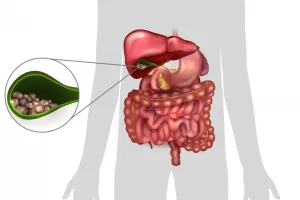What are gallstones and why do they happen?
Medically Reviewed by Dr Fat Poon
Last updated on 11.06.2024
What are gallstones?
- Gallstones are hard deposits that form in the gallbladder
- The gallbladder is a sac-like organ located just under the liver- it stores bile which is a yellow-green liquid formed by the liver, that helps to digest food.
- When you eat, the gallbladder contracts, and squirts bile into the intestine.
- Gallstones can consist of different substances- cholesterol, pigments, or a mixture of both.
- Quite often there are bacteria contained in the centre of the stones.
How common are gallstones?
Around 15% of the population are thought to have gallstones, but most of these people have no symptoms.
Why do people get gallstones? What causes gallstones?
It’s not fully understood what causes gallstones. It may be that a person’s bile contains too much cholesterol or bilirubin (a pigment formed during the breakdown of red blood cells). Or it may be that the gallbladder does not empty properly, and the bile gets too concentrated, allowing stones to form.
Certain factors seem to increase a person’s chances of getting gallstones. These include:
- Female gender
- > 40 years old
- Being overweight or obese
- Sedentary lifestyle
- Pregnancy
- Diabetes
- Liver disease
- High fat diet
- Low fibre diet
- Rapid weight loss
- Medications that contain oestrogen
- A family history of gallstones
- Conditions which cause increased breakdown of red blood cells
What are the symptoms of gallstones?
In most cases, gallstones cause no symptoms at all. However, some people may experience the following:
- Pain in the right upper side of the tummy or just under the breastbone
- Pain may also occur the middle of the back- sometimes this pain will seem to spread from the upper right side of the tummy,around the side to the back.
- Nausea
- Vomiting
- If the gallbladder becomes inflamed/infected (cholecystitis), fevers and chills may also occur.
What are the complications of gallstones?
Biliary Colic- this is when a gallstone gets lodged in the neck of the gallbladder, causing the gallbladder to cramp and spasm as it tries to squeeze against the blockage. Biliary colic comes in intense waves of pain, usually in the upper right side of the tummy.
Cholecystitis- this is when gallstones block the neck of the gallbladder so it can’t empty properly, and the gallbladder therefore becomes inflamed and infected. Symptoms can include abdominal pain, fever, chills, sweats and general unwellness. It can be quite serious, and usually requires treatment in hospital with intravenous antibiotics.
Ascending Cholangitis (Acute Cholangitis)- also referred to simply as Cholangitis, this is when the bile duct (the tube that delivers bile to the gut) becomes inflamed. It can occur if the bile duct gets blocked by a gallstone, leading to bacterial infection which can spread through the body. Cholangitis can be life-threatening and needs to be urgently treated with antibiotics, as well as removal of any blockage.
Blockage of the pancreatic duct- The pancreas is located very close to the gallbladder. Sometimes a gallstone blocks the tube that drains the pancreas (the pancreatic duct), leading to inflammation of the pancreas or “pancreatitis”.
Gallbladder cancer- gallbladder cancer is rare- but people with gallstones do have a slightly higher risk of it in the long run.
How are gallstones diagnosed?
- Based on your symptoms, your doctor may recommend an ultrasound, which will usually show up if there are gallstones in your gallbladder.
- Sometimes other more specialised scans are needed, to clarify the diagnosis.
- You may also need blood tests to check for infection, jaundice, or inflammation of the liver or pancreas.
What is the treatment for gallstones?
- If gallstones are causing no symptoms, there is usually no need for any treatment.
- If pain occurs, painkillers may be needed, and if infection is present, antibiotics will usually be required. Admission to hospital may be necessary.
- Surgical removal of the gallbladder (cholecystectomy) is generally the best treatment for people suffering from biliary colic or acute cholecystitis. It’s usually performed as keyhole surgery (laparoscopic cholecystectomy).
- In the past the operation was often delayed for many months after a bout of biliary colic or cholecystitis, but these days early surgery is preferred, often within a matter of weeks.
If you have symptoms of gallstones or other concerns, speak to your doctor. You can also read more here
Getting a Mental Health Care Plan in Australia: Your Guide
Getting a Mental Health Care Plan in Australia: Your Guide Mental health matters—and if you’re feeling overwhelmed, anxious, or down, a mental health care plan can help. But what is it, and how do [...]
UTI Symptoms and Treatment: What You Need to Know
UTI Symptoms and Treatment: What You Need to Know Urinary Tract Infections (UTIs) are common, uncomfortable, and often disruptive. But what exactly are the signs to watch for, and how can you get relief [...]
Free Mental Health Care Plan Online | Bulk-Billed by Qoctor
Free Mental Health Care Plan Online | Bulk-Billed by Qoctor Discover how to get a free, bulk-billed Mental Health Care Plan (MHCP) in Australia through Qoctor's telehealth service. Accessing [...]






